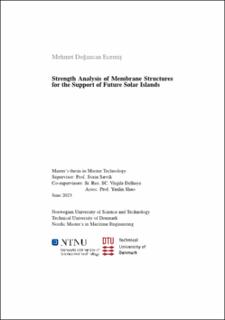| dc.description.abstract | The report provides a comprehensive overview of membrane materials, including their mechanical and structural properties, as well as their applications in various industries. It discusses the behavior of membrane structures and their response to hydrodynamic loads, while also exploring testing procedures. Membrane technology, known for its lightweight and customizable nature, emerges as a promising solution for achieving sustainable operations. The report emphasizes the importance of enhancing membrane performance and conducting strength analysis to support future solar island projects.
In the context of the Master's thesis, a computational model is developed to analyze membrane specimens using ABAQUS software. The thesis describes the experimental setup conducted at the SINTEF Material Laboratory and highlights the subsequent comparison between the computational model and real experiment results. By validating the model through empirical data, the thesis aims to provide a comprehensive understanding of membrane behavior and improve the accuracy of computational predictions.
Moving forward, the thesis focuses on expanding the strength analysis of membranes by incorporating detailed explanations and results from the real experiments. It highlights the significance of integrating experimental data to refine the computational models and enhance their predictive capabilities. The thesis serves as a valuable contribution to the existing literature on membrane structures and materials, offering insights into the mechanical behavior and performance of membranes under various loading conditions.
Additionally, the thesis presents the results of two different types of membrane experiments conducted in the laboratory. The first set of experiments focuses on uni-axial tensile tests, while the second set involves dynamic mechanical analysis experiments at varying stress rates within a specific frequency range. Calibration of the elastoplastic model required additional time due to the limited information available regarding the behavior within the thickness. Experimental and simulated results are compared to assess the computational model's accuracy and reliability in capturing membrane material behavior.
Together, the Master's thesis contribute to the understanding of membrane materials, their behavior under different loading conditions and the development of computational models for analyzing and predicting their mechanical response for the support of future solar islands. | |
